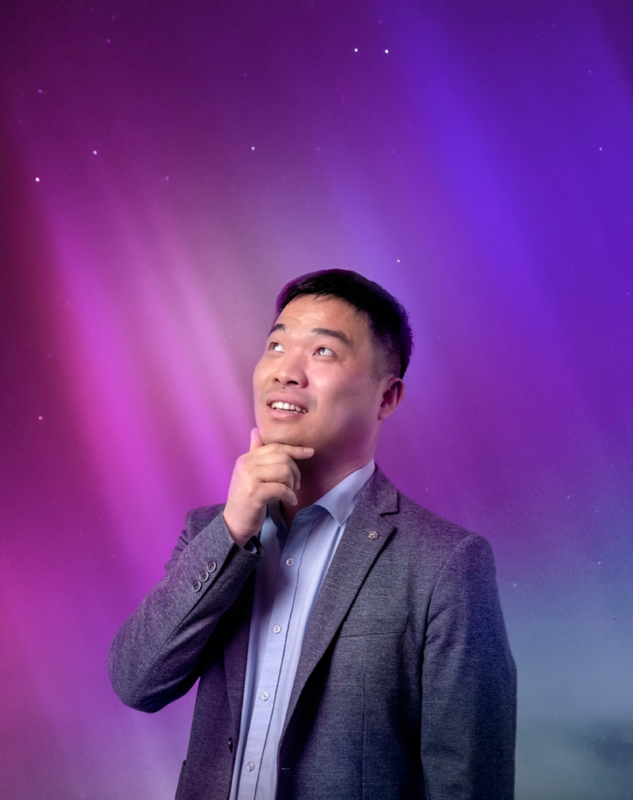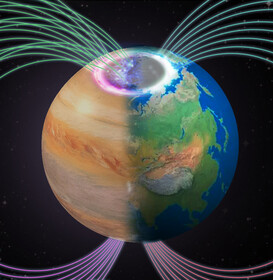
‘Planetary exploration acts as our celestial key, expanding our perception of the universe and consequently transforming our thought processes, thereby yielding benefits for our future on Earth.’
 Professor Zhonghua YAO
Professor Zhonghua YAOAssociate Professor of the Department of Earth Sciences
- 2023 Elected as President of Planetary Science Section, Asia Oceania Geosciences Society
- 2023 HKU-100 Scholar
- 2018 Arne Richter Award, European Geosciences Union
- 2018 Cassini Group Achievement Award
- 2017 Winton Capital Award, Royal Astronomical Society
- 2016 Marie-Curie Research Fellow
Research Interests:
Auroral phenomena and energy processes at earth and other planets; auroral morphologies and auroral particle acceleration; fundamental physics associated with solar-planetary interaction and planetary explorations.
In an era where humanity's gaze is fixed firmly on the stars, the idea of becoming a cross-planetary species is no longer a distant dream. Professor Zhonghua Yao stands at the forefront of this frontier. His career has taken him from the UK and Belgium to Beijing and Hong Kong. His expertise has been instrumental in several international space missions, including the Hubble Space Telescope, Cassini, and Juno. Currently, he spearheads a dedicated team at HKU focusing on the Chinese missions to Jupiter and the Moon. His impressive body of work includes over 180 publications in prestigious journals, with his research frequently highlighted by major media outlets like the BBC and NASA.

A conceptual image illustrating the different aurora between Earth and Jupiter. (Image credit: Professor Zhonghua YAO)
Pioneering Planetary Space Physics
Yao’s research is rooted in planetary space physics — a discipline dedicated to understanding space environments, uncovering fundamental plasma physics processes, and discovering uncharted worlds. His primary focus is on giant planets and particularly Jupiter, where he investigates the planet's magnetic field, particle acceleration, and explosive energy release processes.
‘Aurorae are the visual manifestations of these space energy processes,’ he explains. By coordinating simultaneous observations of aurorae and magnetospheric dynamics, his research seeks to link different auroral patterns to underlying space dynamics. This approach not only enriches academic knowledge but also enhances our capability to study planetary systems through remote sensing.
One of Yao's landmark achievements is his recent study on auroral displays. Since 1979, scientists believed that Earth's and Jupiter's aurorae were distinct. However, his research has uncovered a unified framework that encompasses both auroral morphologies.
‘We discovered that these two disparate auroral displays actually obey the same law,’ he reveals. ‘The interplay of solar wind conditions, rotational speeds, and magnetic strengths determines the morphology of the aurorae.’ This finding enhances our fundamental understanding of how planetary magnetic fields interact with the solar wind, contributing to the monitoring, prediction, and exploration of magnetic environments across the solar system.
Bridging Science and Practical Applications
Yao's research has profound practical applications, from guiding future planetary missions to providing critical environmental data for planetary exploration. His innovative discoveries offer vital insights into framing scientific objectives. For instance, his work has revealed that the main Jovian aurora is significantly influenced by solar wind — a finding that contradicts the prevailing hypothesis established four decades ago.
‘The driving mechanism behind this phenomenon is set to be a crucial aspect of our forthcoming mission to Jupiter,’ he notes. Moreover, his research offers essential data for mission planning, particularly in designing orbits and selecting instruments to withstand Jupiter's highly radiative environment.
Yao’s research journey began with investigating space weather on Earth.
‘Space weather isn't unique to Earth; it occurs on other planets too, though in different forms,’ he reflects. By drawing comparisons between different planets, such as Earth and Jupiter, his work fosters knowledge exchange among scientific communities and reveals universal principles governing planetary environments.
His fascination with the stars and a desire to explore the unknown have driven his academic path. Each step along the way has been marked by rigorous study and profound curiosity, leading him to some of the world’s leading research institutions.
‘Space weather is a field where every discovery opens new doors,’ he remarks. ‘It’s a constant reminder of the vastness of our universe and the intricate connections within it.’
The Impact and Vision for the Future
Looking ahead, Yao is keen on furthering his contributions to planetary missions and enhancing international collaborations. At HKU, he co-established a joint Planetary Physics group with Professor Binzheng ZHANG in the same Department and nurtured valuable connections with groups in mainland China and globally.
‘Our future goals involve pushing the boundaries of our understanding of planetary environments and contributing to the success of upcoming space missions,’ he states. ‘We aim to develop more sophisticated models and observational techniques to provide deeper insights into space weather dynamics across different planetary systems.’
In the words of Yao, ‘The universe is vast and full of mysteries. Each discovery we make is a step towards uncovering the secrets of our cosmic neighbourhood and understanding the fundamental processes that govern it. It is this journey of discovery that drives us forward and fuels our passion for exploration.’
| < Previous | Next > |

